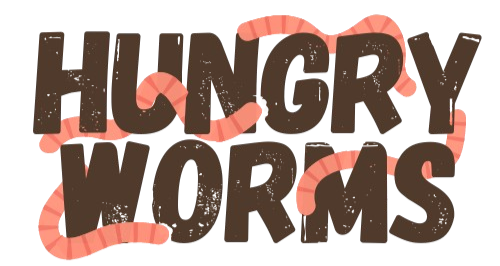
Red Wigglers vs Earthworms and Nightcrawlers
Share
Most people understand that there are many species of earthworms, but often they are suprised to know that earthworms have preferences about how they live in the soil profile.
Almost all of them can be classified into three groups based on their favorite place in the soil.
Let's talk about it!
Red Wigglers vs Earthworms - The Similarities


Anyone who knows what an earthworm looks like would recognize a red wiggler as an earthworm.
Because red wigglers ARE earthworms.
They are biologically classified as the same kingdom, phylum, etc. all the way down to being in the same family.
But to understand the primary differences between Red Wigglers vs Earthworms (or "regular" earthworms), we have to understand the 3 main classifications of earthworms.
The Main Classifications of Earthworms

Red Wigglers: Epigeic Earthworms
Epigeic, meaning "upon the earth" is how composting worms are classified.
They prefer to live only the top several inches of the soil profile - in decaying organic matter rather than soil itself.
Because they prefer to live in leaf litter, they do not make burrows like other kinds of earthworms.
Being so close to the surface, and more exposed to sunlight, they are more pigmented than other earthworms, which is where the "Red" in "Red Wiggler" comes from.
Epigeic earthworms have adapted to eat as fast as possible and reproduce as fast as possible because living only in the top few inches of the soil profile leaves them more vulnerable, and more subjected to, environmental changes than other earthworms who can just burrow deeper to wait out a freeze or drought.
Their thought process is "better eat all this food as fast as possible and lay as many cocoons as possible in case things dry up and wipe us out!"
Or so I assume that's part of their thought process, I haven't mastered worm telepathy quite yet. Stay tuned, though!
Additionally, they don't mind roommates. Composting worms can share the same cubic foot of material with thousands of other worms.
This is why these worms do so well in composting contexts. They're accustomed to living in environments similar to a compost pile.
Endogeic and Anecic Earthworms - The Classic "Nightcrawlers"
The kinds of earthworms that do prefer to live in the soil, are Endogeic and Anecic Earthworms. This means "within the earth" and "emerge from the earth" respectively. These are the ones you see in your yard as you are digging, or you find after a heavy rain.
They make burrows throughout the soil that can be multiple feet deep, and are the "earth worker" earthworms.
They can grow to be quite massive compared to composting worms. They are built to tunnel through soil. They need to have a lot of muscle to do that.
Because they are deeper in the soil, their skin remains more pale than epigeic earthworms. Anecic earthworms, who dig vertical tunnels and "peek" their head out at the surface to grab food and pull it back in their burrow, will have some pigment on their front half to account for potential sunlight it could be exposed to.
In the North Americas, these Anecic earthworms are invasive and do harm to our forest soil profiles by mixing the different horizons together.
They don't do very well in composting contexts as they prefer permanent burrows, aren't adapted to live in that much organic matter, don't eat or reproduce quickly, and don't like being confined and sharing space with other earthworms.
Red Wigglers vs Earthworms/Nightcrawlers - The Differences
Red Wigglers
- Striped
- Darker color across full body length
- Yellow tipped tail
- Usually no longer than 3 inches
- Non-invasive in North America
- Not strong enough to burrow through actual mineral soil.
- Good for composting environments such as a worm farm.
Nightcrawlers
- Not striped
- Pale across the body, except for Anecic earthworms which have pigmented heads as their head is exposed while grabbing food at the soil surface.
- May have a flat tail.
- Usually longer than 3 inches
- Invasive in North America
- Built to tunnel through soil.
- Not good for composting environments such as a worm farm.



Red Wigglers vs Nightcrawlers for Composting
Because nightcrawlers
- prefer to have semi-permanent burrows which are usually very long or deep
- prefer to live in actual soil and not decomposing organic matter
- do not live in high population densities
- do not eat or reproduce quickly
they are not great candidates for a worm farm.
However, this is for nightcrawlers that are truly endogeic/anecic earthworms. There are epigeic earthworms that are referred to as nightcrawlers because they grow so large, such as European Nightcrawlers and African Nightcrawlers. Although they are referred to as nightcrawlers, they are epigeic earthworms and are used for worm farming.
Summary
Red Wigglers and Earthworms/Nightcrawlers are in the same family biologically. Anyone would recognize a red wiggler as an earthworm.
There are 3 classifications of earthworms based on their preferred habitat in the soil profile.
Most epigeic earthworms are not native, but are not invasive to north america. Most endogeic and anecic earthworms are.
Red Wigglers, or epigeic earthworms, prefer to live in the layer of rich organic matter in the soil which makes them good for worm composting.
Nightcrawlers and other earthworms live deeper in the soil and make burrows. They do not prefer a typical composting environment.
Want to get started with Worm Farming? We have everything you need!

Scott Kent
Owner of Hungry Worms. Worm farmer, soil microbiologist, and educator since 2014. Read more about me here.




